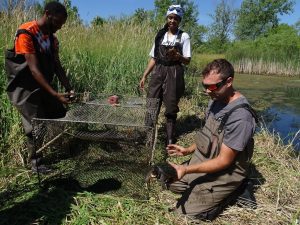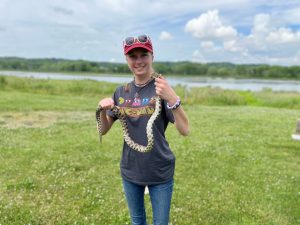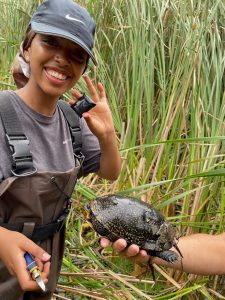Nahant Marsh Summer Interns Present Findings to Public
Davenport, Iowa — Last week, summer research interns at Nahant Marsh hosted an open house poster session to share their projects with the public. 35 community members attended to learn more about the ongoing research done at the Marsh.
 Every summer, Nahant Marsh offers internships to students who enroll in Eastern Iowa Community College’s Louis Stokes Alliance for Minority Participation (LSAMP) summer research program. Students from various local colleges and universities (and sometimes high school) develop and carryout a scientific research project that not only helps them gain experience and improve their skills in the sciences but helps Nahant Marsh learn more about its local ecosystems. This summer, Nahant Marsh hosted eight student interns, and their research findings are summarized below.
Every summer, Nahant Marsh offers internships to students who enroll in Eastern Iowa Community College’s Louis Stokes Alliance for Minority Participation (LSAMP) summer research program. Students from various local colleges and universities (and sometimes high school) develop and carryout a scientific research project that not only helps them gain experience and improve their skills in the sciences but helps Nahant Marsh learn more about its local ecosystems. This summer, Nahant Marsh hosted eight student interns, and their research findings are summarized below.
Vivian Mansion (Augustana College) studied the effect of noise pollution on monarch butterflies in Davenport, IA and Rock Island, IL. She found that as noise pollution increased, monarch butterfly abundance decreased, suggesting that urbanization can affect monarch butterfly populations.
Yussra Semma (Augustana College) used GPS trackers to determine how Blanding’s turtles, a state-threatened species in Iowa, move across the landscape at Nahant Marsh. In her study, she discovered where Blanding’s turtles are locally nesting, which enhances our ability to  protect these sensitive locations.
protect these sensitive locations.
Joseph Struss (Eastern Iowa Community College) captured and identified zooplankton at Nahant Marsh and looked at their biodiversity as it relates to the water quality of the marsh. Zooplankton are microscopic animals that play an important role in the food chain of aquatic ecosystems. He found that some water quality metrics (oxygen and turbidity) were correlated with the presence of certain species of zooplankton and some species were underrepresented at certain test sites, suggesting that water quality could have cascading effects up the food chain.
Alex Branham (Iowa State University) also studied the water quality of Nahant Marsh; however, she looked at the diversity of benthic macroinvertebrates, which are small aquatic animals, many of which are the larval stages of insects such as dragonflies and mosquitos. Her research showed that phosphate levels were relatively high where Nahant Marsh flows into the Mississippi River and macroinvertebrate diversity was relatively low at this site compared to others. This site also had an abundance of backswimmers, a species that can tolerate some pollution.
 Allyson Smithson (Iowa State University) and Olivia Deen (Eastern Iowa Community College) used acoustic song meters to detect the vocal presence of various bat and frog species at Nahant Marsh. Allyson found eight of nine Iowa bat species at Nahant, one of which, the Indiana bat, is
Allyson Smithson (Iowa State University) and Olivia Deen (Eastern Iowa Community College) used acoustic song meters to detect the vocal presence of various bat and frog species at Nahant Marsh. Allyson found eight of nine Iowa bat species at Nahant, one of which, the Indiana bat, is  federally endangered. Olivia documented four species of frogs (bullfrog, cricket frog, green frog, and leopard frog). Although frogs were abundant at all test sites at Nahant, chorus intensities varied among sites and appeared to be stronger in wetlands further from the education center.
federally endangered. Olivia documented four species of frogs (bullfrog, cricket frog, green frog, and leopard frog). Although frogs were abundant at all test sites at Nahant, chorus intensities varied among sites and appeared to be stronger in wetlands further from the education center.
Ali Ali (Wartburg College) looked at the biodiversity of plants in newly-restored, past- restored, and remnant prairies at and near Nahant Marsh. Among these, he found that prairie diversity was statistically similar and concluded that prairie restoration, whether recent or established many years prior, appeared to be sufficient to restore plant biodiversity.
Addison Tiesman surveyed snakes at Nahant Marsh and found numerous common garter, plains garter, fox, and Dekay’s brown snakes. She tagged captured snakes with passive integrated transponder (PIT) tags, which work like a microchip to identify individuals that are re-captured. Her study will help Nahant Marsh determine long-term trends in snake population dynamics.











